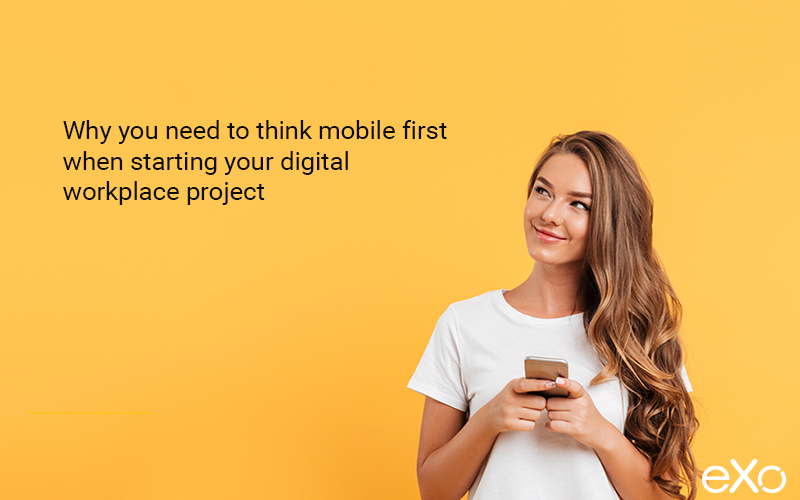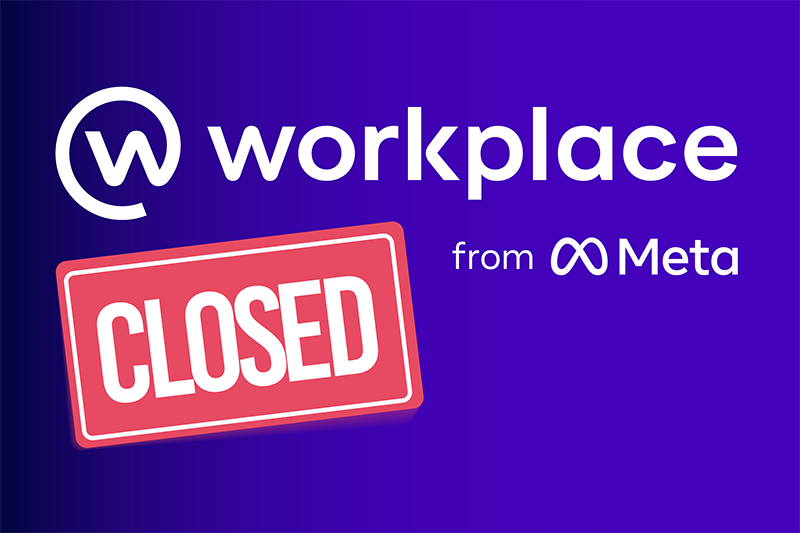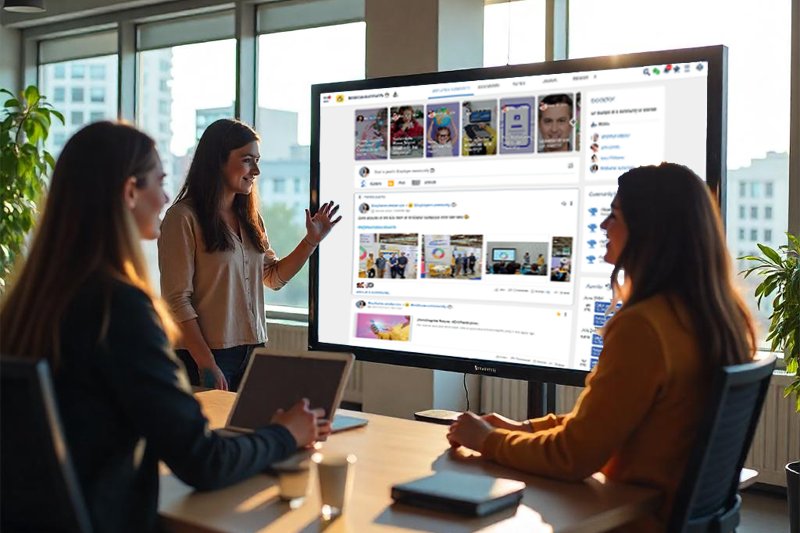- Fares Laroui
- September 9, 2020
Why you need to think mobile first when starting your digital workplace project
Ever since the introduction of mobile devices a couple of decades ago, they have become synonymous with instant connectivity and access to information, which has appealed to both the general public and businesses alike.
However, comparing old Blackberries and PDAs to the smartphones we have today is unfair to say the least. In their early days, mobile devices were primarily used to make phone calls, respond to emails and perform a variety of basic tasks. Additionally, their high price tag made them a luxury with only a handful of people (generally executives) having access to them. This, coupled with the high adoption of desktop PCs, meant that software providers concentrated their efforts on building solutions for PCs.

Content
This all changed following the rise of smartphones and tablets in the late 2000s. Penetration grew year-on-year, with more people – not just professionals and executives – able to afford a mobile device as prices dropped following intense competition between producers.
Advancements in wireless telecommunications technology and the emergence of new mobile programming languages meant that the possibilities were endless in terms of creating a variety of apps and delivering on the promise of convenience and instant connectivity. Use cases for mobile have evolved to cover the majority of our daily and working lives, which has led to an increase in the time spent on mobile devices and has shaped new behaviours and expectations.
As the smartphone market moved rapidly from early adopters to growth, maturity and near saturation, businesses were quick to adapt their offerings for consumers, and their enterprise software solutions for their employees.
In this blog post we will discuss five reasons why you need to think mobile first when deploying a digital workplace solution.
1. Employees expect to access their productivity tools on their mobile device
Employees’ expectations are shaped by the world around them. Millennials and now Gen Z, who both make up the most of the workforce, are tech savvy and have been surrounded by mobile devices since their early years. For these generations, and even older ones who have become increasingly used to the newest technologies, it is virtually unimaginable to spend the day without using their smartphones.
Additionally, most employees expect to work remotely and access their productivity tools and apps anytime, anywhere and from any device, which has put more pressure on businesses to deliver and deploy mobile friendly solutions to first attract, and then retain their talent.
2. Mobile access is critical to the majority of employees
Socioeconomic and technological factors often lead to the creation of new jobs and entire industries that require a new approach and especially new tools. For instance, the global financial crisis has been responsible for the rise of freelancing. This new way of work has seen businesses invest heavily in mobile technologies and others like Uber and Lyft base their entire business model on the gig economy and a mobile workforce who is always on the go.
The Uber economy contributed to the rise of deskless workers, who make up 80% (or 2.7 billion) of the global working population according to the rise of the deskless workforce report. Despite these huge figures, deskless workers have often been overlooked in terms of IT funding, targeted technologies and corporate communication policies, leading to lower productivity, poor engagement rates and no sense of belonging.
3. Get teams to collaborate effectively
Allowing frontline as well as remote employees to access their tools, such as digital workplace solutions and others, wherever they are and from mobile devices is key to guaranteeing increased productivity, real-time access to data and better decision making.
According to The New Decision Makers: Equipping Frontline Workers for Success, a Harvard Business Review study, 87% of respondents stated that empowering frontline workers to make important decisions on time is key for organisational success with a further 86% saying on-site employees need to be better equipped. The study also found that unified communication/collaboration and self-service analytics tools are the technologies respondents expected to see implemented and used extensively by on-site employees in the future. In terms of hardware, tablets, smartphones and wearables represent the devices on which the above tools will run.
For industries with a high percentage of mobile workers such as retail, healthcare, and manufacturing among others, digital workplace solutions shouldn’t only be designed for office employees but the entire workforce.
Take the example of retail, where constant and timely exchange, visualisation as well as processing of data such as sales, consumer behavioural data etc should be performed by a holistic solution accessible via a variety of devices. A mobile digital workplace that can integrate with different business tools and applications used for daily operations such as CRMs and ERPs can lead to better collaboration, satisfied workers and improved customer service.
4. Keep employees informed and build a strong corporate culture
A strong corporate culture is the backbone of any successful organisation. Although there are many techniques and tools to engage and satisfy employees, the key is to reach the right people at the right time through the channels they use the most and in the case of a typical modern employee, it has to be their smartphone.
By deploying a mobile friendly digital workplace, HR, internal communications specialists and of course the C-suite can get their message across the entire organisation and break down silos. Through dedicated corporate newsrooms and features like news and microblogs, employees can stay informed about the latest updates right from their homepage, groups or through notifications. They can also participate in discussions through social features such as likes, comments and shares.
5. Facilitate the implementation of BYOD policies
As mentioned earlier, new generations in the workplace come with new expectations. In addition to wanting mobile friendly solutions, employees nowadays expect to use their own devices at work, in a phenomenon known as BYOD or “Bring your Own Device”. This is a topic that we have discussed in previous blog posts and is increasingly becoming the new norm at a number of businesses. Not so long ago, mobile devices weren’t necessarily supported by most businesses’ IT infrastructure with solutions mainly deployed and used internally in the office.
But today, following the demands of employees and in order to prevent the use of unauthorised devices to access critical information, employees in certain businesses can use their own devices to communicate with their peers, collaborate on projects and get things done. In order for a BYOD policy to be effective, there are three fundamental elements to consider: which devices will be used, who will manage support and security and of course the applications used. The latter need to be flexible and adaptable allowing access from mobile devices through dedicated applications.

FREE WHITE PAPER
Types of Digital workplace solutions
The modern workplace has evolved significantly in recent years, with advancements in technology, the growing number of tools …
- Tags: Digital workplace
Rate this post
I am a product marketing specialist at eXo. My role is to assist marketing and sales teams in their operations and present our digital workplace solution to the world. I mainly blog about the latest tech trends, digital transformation, internal communication and how to navigate through eXo Platform.
Related posts
- All
- eXo
- Digital workplace
- Employee engagement
- Open source
- Future of work
- Internal communication
- Collaboration
- News
- intranet
- workplace
- Knowledge management
- Employee experience
- Employee productivity
- onboarding
- Employee recognition
- Change management
- Cartoon
- Digital transformation
- Infographic
- Remote work
- Industry trends
- Product News
- Thought leadership
- Tips & Tricks
- Tutorial
- Uncategorized
Leave a Reply
( Your e-mail address will not be published)
Connexion
0 Comments
Commentaires en ligne
Afficher tous les commentaires


